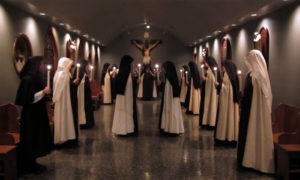
Advent and the Liturgy
In this Edition:
- Advent and the Liturgy
- Website News
- Community News
Dear Friends of Carmel,
Advent and the beginning of another liturgical year—so hard to believe another year has passed on our path to eternity and Heaven! Beginning another liturgical year is meant to bring us all back to a vivid remembrance of God’s purpose and plan of Redemption—and the call to holiness that His redemptive work has won for us.
The holy Benedictine Abbot, Dom Gueranger, animated by his love for the liturgy, wrote about Advent:
“Now during the season of Advent, our Lord knocks at the door of all men’s hearts—at one time so forcibly that they must notice Him, at another, so softly that it requires attention and vigilance to know that Jesus is asking admission. He comes to ask them if they have room for Him, for He wishes to be born in their house. The house (each soul) indeed is His, for He built it and preserves it; yet He complains that His own refused to receive Him… ‘But as many as received Him, He gave them power to be made sons of God, born not of blood, nor of the flesh, but of God.’ (St. John, ch.1)… Make room for the Divine Infant, for He desires to grow within your soul. The time of His coming is close at hand; let your heart, then, be on the watch; and lest you should slumber when He arrives, watch and pray… The words of the liturgy are intended for your use—they speak of darkness which only God can enlighten; of wounds which only His mercy can heal; of a faintness which can be braced only by His divine energy.”
This strong and loving invitation to make use of liturgical prayer as our own very personal prayer is a new thought for some people. Yet it has always been the practice of Christians to carry with them as an interior lamp ever burning the prayer inspired by the Church’s divine worship. Here are a few lines from the beloved hymn of Advent, “Creator Alme”.
Jesus, loving Creator of the heavens, eternal light of believers and Redeemer of all mankind, hear the prayers of those who cry to You.
For, urged on by generous love, You became a healing power to a sick world to prevent it being, through the devil’s wiles, sick even to its death…
We beseech You, our mighty Judge at the last day, defend us with the arms of heavenly grace from our enemies…
We have learned that good priests make the liturgical life the very foundation of their spiritual life and priestly vocation. They find in the prayer and worship of the Church the source of learning and virtue, as well as a deep friendship with Christ. In it they seek God’s will and purpose for their priestly life—the offering of the Holy Sacrifice, administering the Sacraments, preaching the Gospel, guiding souls in their times of trouble…every aspect of their apostolate has its source in some way in the holy liturgy. But what about a priest who only seven years after his ordination found himself unable to carry on any active apostolate at all, unable even to walk? This priest was Father Francis Xavier Lasance (1860-1946). In spite of the ill health that forced him to relinquish parish work, his zealous liturgical spirit found a way to continue an apostolate that reached far more souls than he ever would have been able to help as a simple parish curate. From 1890 until his death, he lived a “retired, semi-invalid existence” at a Cincinnati hospital, writing spiritual books, as well as compiling and editing books of prayer. These devotional works proved to be so successful in helping souls, spreading Christian faith and promoting the spiritual life that the Holy Father, Pope Pius XI, gave blessing and approbation to his unique apostolate, hidden though it was in the quiet life of a priest who rarely left his room. In every one of his books, whether it was reflections for religious vocations and consecrated life, guidance for young people, or encouragement for those in sorrow and suffering, he found his inspiration in liturgical prayer—and directed people to it.
Although for years most of Father’s books were out of print, thankfully, because of a renewed interest in traditional Catholic life, teaching and prayer, many of these books have been re-printed. In fact, his work is once again enjoying widespread recognition. We ourselves are pleased to offer a selection of his books and highly recommend them as excellent gifts, especially The Blessed Sacrament Prayerbook, Our Lady Book, and My Prayer Book. We plan to add to this selection in the future on our new web site.

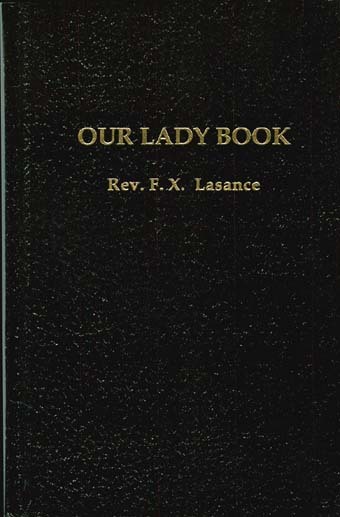
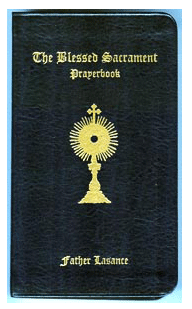
WEBSITE NEWS
We are always asked, sometimes in a panic a week before December 25th, “Quick, Sisters! Give me a list of ideas for Christmas gifts for my family!” Here are a few suggestions:
Rosaries – We are still able to make custom rosaries to arrive in time for Christmas. Also, check our Rosary Gallery, where you will find a selection of unique gifts, as well as ideas for your custom rosary.
Rosary bracelets – Now, in addition to the sterling and rose lampwork beads, a variety of Austrian crystal. Our unique “two-toned” bracelet combines silver and gold with beautiful results! As ever, we are hoping to add more selections, of this popular and ever-pleasing gift on our future web site, especially with semi-precious stones.
Books – Those Fr. Lasance books just mentioned make wonderful gifts that are a treasure of prayer that become helpful companions throughout life. Explore all our spiritual books using the helpful categories listed. With the liturgy in mind, you will want to look over our Advent books and Christmas books, especially two excellent new books, Sermons of St. Francis de Sales for Advent and Christmas and Advent and Christmas Wisdom from St. Alphonsus Liguori. Favorite Christmas Carols is one of the oldest “tried-and-true” carol books, and in paperback it makes an easy book to carry for those caroling get-togethers. The new edition of Abbot Marmion’s Christ, the Life of the Soul brings this holy Benedictine’s beautiful spiritual counsels to more readers. See our Newsletter Archive for other highly recommended books reviewed in past newsletters.

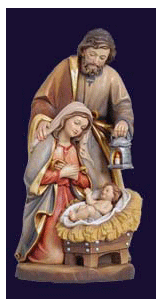
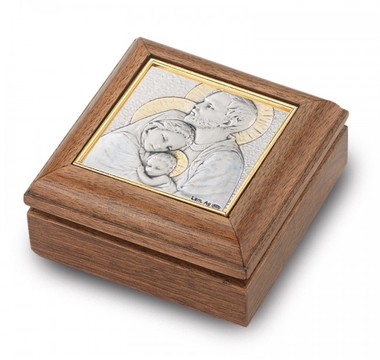
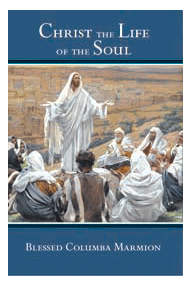
COMMUNITY NEWS
We thought we might use this newsletter to answer a few of the questions asked over the years about our life as Carmelites. If you haven’t already, you may like to read our general description of our daily life and schedule.
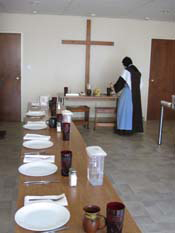
“What do the Sisters eat?” It is usually about the very simplest things of life that people want to know—how they are different in Carmel from what they are in the world. And, of course, food being the “universal topic”, everyone wants to know about what Carmelites eat! In our last newsletter, we happened to mention our late-summer treat of plum dumplings, and did that ever capture readers’ notice! In addition to what is mentioned in our article linked to above, you will be interested to know that our Holy Mother St. Teresa specifically says in the Constitutions of the Order, “The Prioress should see that the food which God is pleased to send them be well prepared, so that the Sisters may be able to take what is given to them, since they have nothing else for their maintenance.” This practical instruction forms our rule for cooking: give your heart diligently to the work of cooking for the spouses of Christ as though serving Christ Himself. Except for fish, the Carmelite diet is vegetarian. Our Holy Mother, St. Teresa made one exception, and that is when a Sister is commanded to eat meat for reasons of health.
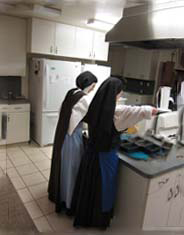
We didn’t mention beans in our list of foods in the above article. Yes, beans. Everyone knows they have plenty of nutrition, but even so, beans tend not to be a food of choice out in the world, and some of our young Sisters have not known much beyond refried beans. But in Carmel beans are a food of choice. The Sisters make a vegetarian chili with kidney beans that is excellent! A beans-with-rice dish, as well as bean burgers are pretty common fare. But the Sister Cooks recently discovered another delicious way to use this protein rich food: pudding. Well-cooked beans, a banana or two for sweetening, a little vanilla, and maybe some cocoa, all blended in the food processor. Served with a slice of toast and a piece of fruit, and we have a nutritious and quick collation (evening meal during fast time). Hot vegetable soup (or cold cucumber soup in summer), salmon loaf and roasted potatoes comprises one of our simple wholesome dinners, and baked oatmeal is a favorite collation for the Sisters. Almost every Thanksgiving our Sister who spent some time living in Georgia makes us sweet potato casserole—the pecan topping is a real treat for us!
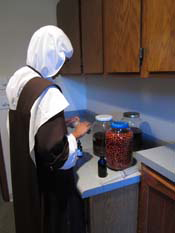
“Do the Sisters use medicines and medicinal herbs, like the monasteries of old?” Over the years, we’ve received questions about how we treat ailments in Carmel. Thank the good Lord, we all have pretty good health, but yes, as a matter of fact, for small ailments, we do use some herbal treatments and make a few of our own herbal tinctures. We have a big aloe plant and find it the very best way of treating burns from work in the kitchen. For bumps and bruises, arnica comes to the rescue. And for our chapped hands (always in winter), calluses and sunburns, we recently were introduced by friends to “vintage TRADITION” balm made from beef tallow—works great!
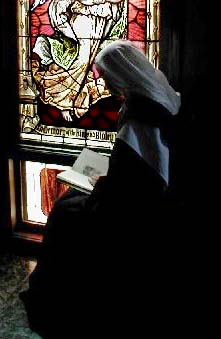
“What do the Sisters read?” We’ve written so many times in past newsletters about spiritual reading and how important it is for the soul’s progress. From our Carmelite Constitutions: “The Prioress should take care that the Sisters read none but spiritual books, and such as are approved by the church, especially the following: The New Testament, the works of our Holy Mother, St. Teresa and of St. John of the Cross; the Story of a Soul by St. Therese of the Child Jesus; The Imitation of Christ; and other approved spiritual books, for such reading is not less necessary for the support of the soul than food is for the body.” We can add to the list the catechism and the Psalms. The recommended choice of reading, as discussed earlier, will often depend on the liturgical season, so now in November, Sisters are reading about the life of the Holy Souls in Purgatory, that place of mercy, contemplative expiation and purification. Of course, we can assure you that for the work projects that so fill our life, such as embroidery, gardening, sewing, cooking, etc., we often use reference books that teach us much!
We promise to respond again to more of the questions and suggestions for future newsletters. And we promise our continued prayers as we come to the holy time of Advent. May it be a season of peace and prayer, despite the busy days.
In Our Lord, the King Who is to come,
Your Carmelite Sisters
